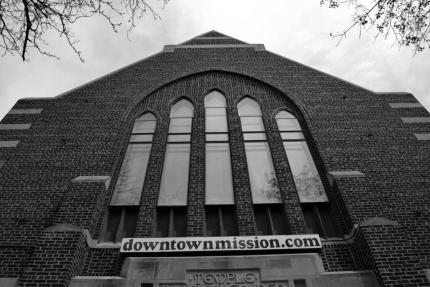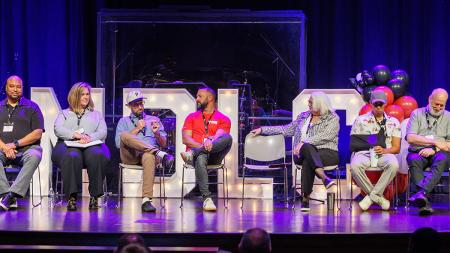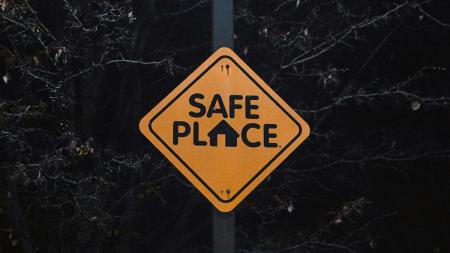Touring the Downtown Mission during Inspire 2019

Downtown Mission
Rev. Jim Hatt had conducted the weekly Friday worship service at the Downtown Mission in Windsor, Ont., a few hours before a dozen or so Inspire 2019 participants, myself included, arrived for a tour.
Filing in, we took seats in the sanctuary of a former church building that serves as the mission. Once we were settled, Hatt, the mission chaplain, explained that he had an experience earlier in the day that he believed captured the spirit of this place located in the heart of Windsor.
“Things went as usual at the service,” said Hatt. “But when we finished, a man came up to me and wanted to talk. He was obviously hurting and in pain.”
So they sat down together, he said, and the chaplain simply listened to the man for a long time — an example of what he and others at the mission, which is faith-based but not affiliated with a church, is all about. “Every day we see ourselves as being God’s hands and feet. I was God’s ears for him this morning.”
The visit to the mission, which started up in the early 1970s through the efforts of a group of concerned Windsor citizens, was included as one of dozens of workshops and seminars offered at Inspire 2019 (Aug. 1-3), the CRCNA’s second binational gathering, which drew people from across North America to meet at the St. Claire College Centre for the Arts.
Besides the workshops and seminars, times of lively worship and a host of plenary speakers were featured at Inspire 2019.
Rukshini Ponniah-Goulin, development director for the mission, took over after Hatt shared his story. She had the role of leading us on a tour of the mission, located for the past several years in the former church building.
“The mission was begun many years ago in the basement of another church. It served coffee and donuts to an average of 20 or so men a few days a week,” she said. “It was provided as a place of comfort and refuge.”
It is still a place of comfort and refuge, but the numbers and services it offers have exploded.
Over time, as the number of those coming to the mission have mushroomed, services have grown to include meals for anyone in the area who is hungry, a homeless shelter, counseling, and, more recently, job training. Also available are yoga classes, art therapy, a long-term addiction recovery program, and a dental clinic.
“We have always welcomed everyone without asking questions. We serve whoever comes to us, and from there we talk about whatever a person might need,” said Ponniah-Goulin.
From the sanctuary, Ponniah-Goulin took us downstairs into the eating area, which today also serves as a temporary drop-in center. A few people sat at tables, talking together in low voices. A couple of young men watched a program on a big TV. One woman, her eyes half-closed, idly tapped the table next to her plate of uneaten food.
We learned that an average of 775 men, women, and youth come through this center every day for breakfast, lunch, and a light dinner. The food is prepared in a commercial kitchen that is set up to make 100 meals a day and clearly far exceeds that capacity.
But there are lots of folks who pitch in to help.
Walking through the kitchen, Mark Gillett, one of the mission employees, mentioned one of those people who help — an area commodities broker he knows who sets aside time from managing money to work in the kitchen washing dishes.
“He is one of so many people we have who work or volunteer or who are involved in some way and have the gospel rooted in their hearts,” said Gillett.
An energetic man with a quick smile and shaved head, Gillett was on the Inspire 2019 planning team. With ties to Ambassador CRC, the local congregation that welcomed Inspire 2019 to town, Gillett suggested the mission tour as one of the workshop options.
“I love this place,” said Gillett, who formerly worked for several years at the Capuchin Soup Kitchen, a ministry of the Franciscans, a Roman Catholic order, on the East Side of Detroit.
He was there while studying for his Ph.D. at the Ecumenical Theological Seminary, also in Detroit. He took a job as the new enterprise center director at the Windsor Downtown Mission about two years ago. He would tell us about that role later.
Focusing for now on the mission, he said: “There is a wonderful narrative of what has been going on here for a long time, and I wanted people in our denomination (CRCNA) to see it.”
We soon left the former church and made our way toward another building, into which the mission will soon be moving. But even that move will be temporary because the city of Windsor is in the process of selling its downtown library to the mission.
“This mission — just like the Capuchin — has been [showing] Christ’s heart and doing Christ’s work in real ways. We are well known in Windsor,” said Gillett. “We have 2,500 donors who help us respond to the needs of people who arrive at our doors.”
As we walked, we could see the Detroit skyline looming across the Detroit River to our left, sunlight glinting on office towers. But here, the area was pretty harsh.
We walked past people lounging in doorways, a front porch on which a woman talked to herself and kept pulling a brush out of her back pocket to drag through her hair, and an alley in which a few men sat at a makeshift table drinking.
These are people whom the mission helps — and there are many others. One who has made a lot of progress is Kevin, who was once living on these streets and in the throes of alcoholism before he found the mission to be a lifesaver.
Later I had a chance to read about Kevin in the Downtown Mission’s most recent newsletter. His story is a telling example of what the mission does. I learned how Kevin, estranged from his immediate family, moved from northern Ontario, where he had been a painter, to downtown Windsor.
He was drinking heavily and living in his car. At one point he spoke of suicide while talking to his cousin in a cell-phone conversation. Worried, the cousin called the Windsor police, who were able to track Kevin down and take him to a hospital. That was at Christmastime last year.
In the hospital a mission representative connected with Kevin and arranged for him to enter the mission’s Phoenix program for recovering addicts.
“I threw myself into the program,” Kevin said. He took advantage of therapy and had time to examine himself and where he got off track. In addition, he began going to Alcoholics Anonymous meetings. He now volunteers in the mission clothing bank. “It’s all about helping others now. I’ve taken care of me; now I want to help others.”
Next on the tour was the building that once housed a hospital and various offices and social-service agencies. Ponniah-Goulin, our tour guide, showed us the fully stocked food bank and took us upstairs to see some of the rooms where people from the streets can spend the night. Beds were piled with clean linens and a few belongings of people who would return in the evening. Sunlight poured through the windows, giving the dorm rooms a home-like feel.
Then we went back downstairs to visit Chari-Tees, an enterprise work program that trains people to do graphic design or to learn the basics of screen printing in partnership with Vistaprint, a large printing company. Baseball caps and t-shirts emblazoned with various logos and emblems were displayed on shelves, and workers were putting together information for Vistaprint when we stopped by.
Tonya Gecelousky, the print-shop manager, said they train people who come to the mission to have skills they can take with them and use in other settings. In addition, by working in the print shop, they can build a resume.
A graphic designer by trade, Gecelousky said she could have gone elsewhere to work, but she is drawn to the mission because of what it does and who it works with.
“The Downtown Mission is a core necessity for Windsor and helps people in so many ways,” she said. “I chose to work here because it is a way of giving back to this community. There is an important feel-good aspect to it at the end of the day.”
As the tour drew to a close, Gillett took us to another room, offered us something cold to drink, and spoke of the importance of training people and finding jobs for them as part of the mission’s overall outreach. People show up hungry and homeless, and a fair number of them have the chance to eventually turn their lives around and find work.
Whether it is in the print shop, in area factories or restaurants, or with other businesses with whom he has built ties, Gillett seeks to bring people through a process that both enhances their self-esteem and gives them the skills necessary to make a living in a world that can so often seem to be stacked against them, he said.
This is a practical effort for him, helping to establish the enterprise employment program, but he said there is also something else that harkens back to his time at the Capuchin Soup Kitchen.
“I learned a great deal while working there, and I can bring the insights I gained — especially about the challenges people who are poor face — and translate them here,” he said.
Although the mission isn’t a church, God is everywhere in it.
“I believe the Lord will touch the people who come through here. We want to keep it business friendly — and yet this is all grounded in the gospel and what God would have us do.”
On the bus back to the St. Clair College Centre for the Arts, many of us were silent. I’m not sure what others were thinking, but in my mind I kept going over the narrative Gillett had given us that steamy afternoon in early August.
It’s the narrative of people such as Kevin, who found help in the Phoenix program; of the man the chaplain spoke to earlier that day; of local volunteers who come to help out with washing dishes and so many other tasks; of the people who come in every night to crawl into clean linen for a good night’s sleep. It’s also the narrative of the joy and satisfaction that Mark Gillett and other dedicated mission staff seem to be getting from the work, rooted in faith and lifted by hope in Christ, seeking to share what God would have them do in Windsor.


